 For 2018, Chrome received a huge number of different updates. This browser has many different useful features that you will not find any information about in the official Google patch notes. Please be aware that some of these features may be removed in the future.
For 2018, Chrome received a huge number of different updates. This browser has many different useful features that you will not find any information about in the official Google patch notes. Please be aware that some of these features may be removed in the future.
- # 1: copy the link from the address bar
- # 2: We receive notifications Facebook and Twitter in the browser
- # 3: Swipe Tabs
- # 4: turn on the new interface
- # 5: Downloading the page when connected to the network
- # 6: Watching Several Tabs at a Time
- # 7: Search by selected word
- # 8: adding the home button
- # 9: Save Pages as PDF File
- # 10: Sending Messages by Email, Fast Calls
- # 11: Changing the page scale
- # 12: Adding More Search Engines
- # 13: Fast scrolling of search results through the “Find on page” mode
- # 14: Turn on the new context menu
- # 15: Muting site sound
# 1: copy the link from the address bar

There are several ways to copy the link of the page you opened. The most famous is to click on the address bar, highlight the link and then click “Copy”. Not very fast, especially since you constantly have to select an entire line to get the context menu to appear. Fortunately, there are faster methods.
Click on the main menu button (3 vertical dots in the upper right corner of the screen) – “Share” – “Copy”. Another way: hold down the address bar, and click “Copy” in the menu that appears. If you see a green lock at the beginning of the line, click on it and hold down the link to copy.
Last but not least, if you are using tabs, just hold your finger anywhere on the top line and the link will be copied.
to the content
# 2: We receive notifications Facebook and Twitter in the browser

The application Facebook for Android cannot be called good, especially in light of recent events. Things are a little better with Twitter, but if you use these applications frequently, you probably don't want them to take up space on your smartphone. In such cases, our second life hack will come in handy.
To receive notifications from the site Facebook, you need to do the following: go to your account on the site itself – click on the menu icon in the upper right corner of the page – in the menu that appears, find and click “Account Settings”. Then tap “Alerts” and slide the “Send Alerts” slider to On.
To enable notifications in Twitter, login to the mobile version of twitter.com and click on the notifications button. In the menu that opens, find the button for turning on notifications. If not, click on the settings button in the upper right corner of the screen, select “Push Notifications” and then click “Enable”.
to the content
# 3: Swipe Tabs
Typically, to switch tabs, users click on the corresponding button and select one of the saved tabs. But there are two more ways to switch between tabs. First: swipe left / right on the address bar. Second, swipe down on the address bar to open a list of available tabs.
to the content
# 4: turn on the new interface

Google never stops experimenting with the Chrome interface. If you want to try out the chips that are in testing, enter in the address bar: chrome: // flags / # enable-chrome-modern-design, and you will be presented with a whole list of different settings that you can enable or disable as you wish. After any changes, you must restart the application twice.
to the content
# 5: Downloading the page when connected to the network
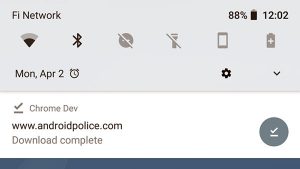
If you need to visit a certain page, but the connection speed is lame, and reloading does not help in any way – Google has come up with a great solution. If you try to load the page while the internet is disconnected or the connection is poor, you can click on the “Download when connected to the network” button. As soon as you connect to the network, Chrome browser will download the selected page and send you a notification.
to the content
# 6: Watching Several Tabs at a Time

The filing cabinet tab menu in Chrome for Android looks very attractive, but it's not the best way to manage a lot of tabs. If you want more of these tabs to be displayed in the tab menu, in Chrome there is an option to turn off the preview of tabs in the menu to switch them. Enter chrome: // flags / # enable-accessibility-tab-switcher in the address bar, select “Enabled” from the menu that opens and restart the application.
to the content
# 7: Search by selected word

This is a very simple feature, but not much is said about it. When you highlight a word or phrase in your browser, a panel appears in front of you. By swiping up the panel, the system will perform a search query for the selected word or phrase.
to the content
# 8: adding the home button

On some devices, the Home button is available in Chrome by default. Since some manufacturers add ChromeCustomizations.apk as a pre-installed system application, which adds this very button. If this application is not on your smartphone, then you will not be able to install it.
But there is one way: go to the browser service page. To do this, in the address bar, enter: chrome: // flags / # force-enable-home-page-button, and select “Enabled” from the menu that opens. Then restart the application twice. After that, the home button should appear.
to the content
# 9: Save Pages as PDF File
As noted earlier, Chrome has the ability to download pages when you don't have network access. But what if you want to send the downloaded page to someone else, or so that it becomes possible to open it through other applications?

Open the page you downloaded, in the main menu click “Share” – “Print” – “Save as PDF”. Then press the blue button to download the file. Done! It is now a PDF file that can be opened by various PDF reader applications on PCs, smartphones or tablets.
to the content
# 10: Sending Messages by Email, Fast Calls
If you use Safari on iOS, you may have noticed that phone numbers and other data are automatically turned into links. For example, tapping on a phone number will open the dialing applications. Chrome browser for Android has something similar, but without any links.
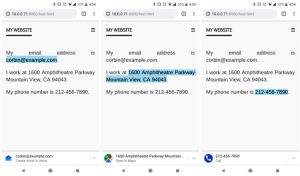
After selecting the email address, a button for writing a letter will appear at the bottom. By clicking on the usual address, a button will appear below, offering to show the location at this address in Google Maps, and by highlighting the phone number, a call button will appear below.
to the content
# 11: Changing the page scale
Many sites do not allow using the zoom in / out function. This can be annoying at times, and the worst part is for users with poor eyesight. Fortunately, you can fix this gap in your browser settings.
We go to “Settings” – “Accessibility”, and tick the box “Forced zoom”. Now you can zoom in on any page!
to the content
# 12: Adding More Search Engines
Over the years, Chrome has supported a fairly limited number of search engines: Google, Yahoo, Bing, Ask.com and Yandex. And only in 2017, with the release of the update to version 57, it became possible to add other search engines.
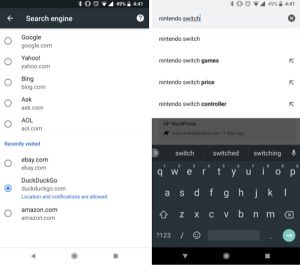
Although the implementation is somewhat lame, it is not that hard to do. First, open a page. Then go to settings and select “Search engine”. In the menu that opens, you will see a list of available default search engines and those you visited earlier, click on one of them, and it will be set as the default search engine.
to the content
# 13: Fast scrolling of search results through the “Find on page” mode
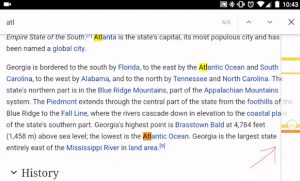
When you use the search mode on a page in Chrome, instead of clicking the arrows to switch between search results, you can do it by swiping on the right edge of the screen.
to the content
# 14: Turn on the new context menu
You probably know that when you long click on an image or link, a context menu appears in front of the user with various options. For example, you can open the link in a new tab or download the image to your phone. Google is currently working on a new context menu that you can try out now.
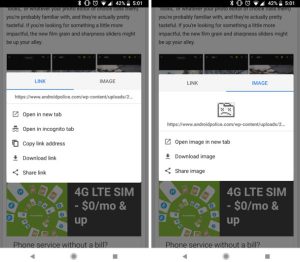
To do this, enter in the address bar of the browser: chrome: // flags # enable-custom-context-menu, once on the service page, enable the new option by clicking “Enabled” and restart the browser. The next time you invoke the context menu, a new option should appear in front of you.
to the content
# 15: Muting site sound
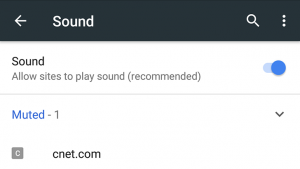
Typically, Chrome tries to turn off any sounds when visiting a site, but some of them are able to bypass the blocking. You can solve this problem by manually blocking the playback of sound from all sites, except for some.
There is nothing complicated about it. It is enough to open the settings in the Chrome browser, then click on “Site settings” – “Sound”. Disable the slider and add a couple of exceptions if you have any.
We were glad to share with you 15 life hacks for Google Chrome at Android. Write in the comments if we forgot something.
